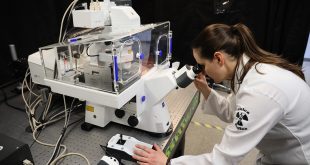By Jana Manolakos
Take a look at a map of the electricity grid and you’ll be able to pinpoint where the research and diagnostic facilities are located. Other than data centres, they’re the sites using the most power. A major frontier in energy efficiency – staying ahead of electricity use – is a challenge taken up by laboratories and organizations like McGill University, the Canadian Coalition for Green Health Care and LifeLabs.
According to McGill, a fume hood with a sash opening of 50 per cent 24/7 will consume the equivalent energy of four typical Canadian households in a year. When you factor in the number of laboratories in the country using fume hoods and fume extraction systems, electricity consumption quickly adds up – and so do the costs.
Sustainable Labs Canada points out that the federal government alone has almost 200 laboratory sites across Canada where scientific research is being conducted in over a dozen major fields of scientific interest. Almost every province and territory directly owns and operates one or more research facilities. Canada has more than 80 degree-granting universities, all with campus research facilities. There are nine major research parks across the country, including both public and privately owned, while at least 40 research hospitals across the country collectively generate over $2 billion in research income annually. Collectively, these facilities use a lot of power.
Since 2006, the Government of Canada has invested billions to reduce greenhouse gas emissions by boosting energy efficiency as well as clean energy technologies and the production of cleaner energy and fuels. One such initiative was a study conducted by the Canadian Coalition for Green Health Care, with funding from Natural Resources Canada and BC Hydro, looking at power consumption of MRIs, CT scans and X-rays. Released in late 2016, the study was conducted in partnership with Nanaimo Regional General Hospital, University Health Network, SickKids and the University of Toronto. The report made recommendations on purchasing protocols, behavioural guidelines and cooling requirements.
Coalition co-founder Kent Waddington explains, “The work we did centred on learning more about the potential to have diagnostic imaging equipment Energy Star certified. We did it to see how much energy these machines use when in operation, idling or shut off.” The researchers discovered machines that were constantly idling or on low power mode consumed more energy over the long run when compared to actively running equipment, which is often turned off when not in use.
At McGill University, studies like this are taken seriously. Known for its stunning architecture and world-class academics, McGill University can now add carbon neutrality to its reputation. It’s in the homestretch of a three-year climate and sustainability strategy, Vision 2020, aimed at achieving carbon neutrality by 2040. McGill is also one of several Canadian universities to earn gold-level recognition from STARS, a program of the U.S.-based Association for the Advancement of Sustainability in Higher Education. McGill now has its sights set on platinum, the association’s highest possible recognition.
“We knew that if we were going to address climate change on campus, we needed to think beyond 2020. That is why we set these long-term targets,” says McGill’s Sustainability Director, François Miller. “McGill’s extensive collection of heritage buildings, as well as our research-intensive profile, make these targets a unique challenge, but this new plan sets out a roadmap for the long journey ahead.”
In 2014, the university produced a comprehensive guideline for sustainable lab practices, with tips on efficient use of lab equipment such as refrigerators and freezers, hot plates, shakers, cooling baths and fume hoods. The goal was to engage the university community; promote and recognize efforts to reduce material, water and energy consumption while maximizing cost savings; and improve safety and accessibility through optimizing operations, training and awareness.
Awareness is often the first step. “We’ve worked hard over the years to get the message out there that knowledge is transferrable – that the same mentality you use at home applies at work, too,” Waddington explains. “Shut your light and your computers off when not at work. You don’t need your scanner on all night when you are not there. If you see a dripping tap, report it. We all have a part to play in this, and that means looking at what we do every day at work and at home and making an effort to consume less, be more conscious of how we purchase, what we throw away and how much energy we use, because all of these little bits do add up.”
That was the case for LifeLabs, a provider of laboratory diagnostic information and digital health connectivity systems. This May, the organization won its second Environmental Excellence Award from Practice Greenhealth, a U.S. organization dedicated to environmental sustainability in health care.
The only lab in North America to receive the award, LifeLabs’ International Reference Lab in Toronto and Burnaby Reference Lab were recognized for sustainability and waste reduction. Among a number of environmental improvements such as installing an ozone treatment system to remove contaminants from water, LifeLabs converted more than 2,200 fixtures to LEDs in its facilities across Canada to increase energy efficiency and it took steps to convert 70 per cent of its mobile service fleet to hybrid vehicles.
“We’re honoured to be recognized for the innovation of our operations to promote environmental sustainability and waste reduction,” says Tanya Martin, VP of laboratory operations for LifeLabs. “It’s important for us to be an environmental leader in an industry that has historically produced a lot of waste. We believe we’re making a difference to the environmental sustainability of our communities.”
Many of the steps a lab can take are obvious, such as shutting off equipment when it is not being used. What is less obvious is how to motivate everyone to participate in saving energy and resources. Sometimes it comes down to numbers, and more importantly, dollars – in which case, this success story should help: The Timmins and District Hospital in Ontario was able to save more than $500,000 on its energy bills in the first year following an ambitious retrofit project that halved the number of fluorescent bulbs (from 8,000 to 4,000) and optimized the building control systems for heating and lighting, depending on hours of occupancy. In total, the energy efficiency project reduced the hospital’s yearly natural gas consumption by approximately 750,000 cubic metres.
 BioLab Business Magazine Together, we reach farther into the Canadian Science community
BioLab Business Magazine Together, we reach farther into the Canadian Science community





